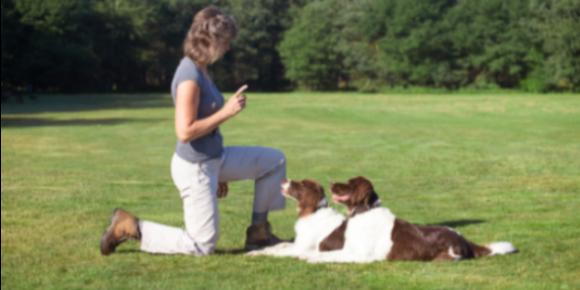
- posted: Feb. 03, 2024
When dogs are left to their own devices, they tend to do a lot of very normal dog behaviors, barking, digging, jumping and maybe even pottying in the house! It’s our job as the humans, to help them know how to behave appropriately. How do we do that? We train them.
In addition to lessening unwanted behaviors, positive reinforcement training: enriches the relationship between you and your dog, helps your dog understand what you want, and eases frustration, for both of you.
The complexities of dog training mostly involve us humans. When we take the time to teach, dogs can learn. It also takes some patience and understanding of the learning process. Training using food, treats, toys and praise is not only the most humane and ethical way to train animals, it’s also fun, fast and effective!
Key terms to know;
- Operant Conditioning - the learning process in which a behavior is strengthened or weakened based on consequences.
- Reinforcement - a behavior is strengthened by adding (positive) or taking away (negative) something.
- Positive Reinforcement - the giving or adding of a treat, toy or petting (something the dog wants) to strengthen behaviors you want.
- Negative Reinforcement - the taking away of something your dog finds aversive in order to increase the likelihood of a behavior strengthening.
Dogs learn through associations in their environment, or “classical conditioning.” When we shake a treat bag, the dog comes running because they have learned that when the treat back shakes, they get a treat. They know that sound. We can take that one step further and teach dogs that a click from a clicker means a treat is coming. Or we can teach them to associate a treat with a word like “Good” or “Yes” to let the dog know when they have done something right. The key is timing.
When your dog sits, say, “Yes!” or click your clicker right away and give a treat within 3 seconds. If the treat is given immediately after the desired behavior, the dog is likely to associate the behavior (sit) with the cue “sit” and repeat the behavior. You just used Classical Conditioning and Operant Conditioning to teach your dog to sit! You’re training your dog!
The idea is to teach our dogs what we WANT them to do instead of punishing them or saying “NO” to unwanted behavior. Dogs don’t understand the concept of “No”. It might interrupt naughty behavior in the moment, but when that situation happens again, your dog is likely to repeat the naughty behavior because they still don’t know what you want from them.
This kind of Operant Conditioning and positive reinforcement can be used to teach your dogs a number of appropriate behaviors like: sit, down, come (recall), stay, leave it, walk politely on leash…and so much more! By taking the time to train your dog you’re helping him/her understand the kind of behavior that is safe, expected and appropriate. In addition your dog will feel more secure, confident and connected with you!
By Janet Krasno, Coach Krasno Dog Training
Janet Krasno is a Certified Professional Dog Trainer-Knowledge Assessed (CPDT-KA) and ascribes to the Certification Council’s Values and Code of Ethics. Find more information at http://www.ccpdt.org.
